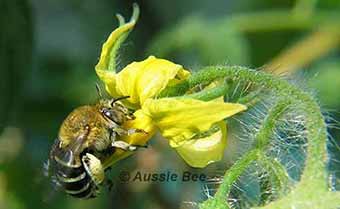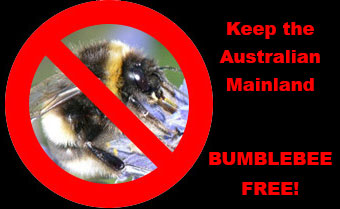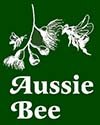2006 REPORT ON BLUE-BANDED BEE RESEARCH AT THE UNIVERSITY OF ADELAIDE
Aussie Bee > Bumblebee Problem > Blue Banded Bee Alternative Pollinator Option > Research Update 2006
Other Aussie Bee reports on the Bumble Bee problem:
-- Debate on using exotic bumblebees in Australia
-- How to identify a feral bumblebee
-- Have you seen a bumblebee on the Australian mainland?
-- What harm could feral bumblebees cause?
-- How far could feral bumblebees spread in Australia
-- Bumblebees and invasive weeds in Australia
Katja Hogendoorn and Mike Keller
5th May 2006
See also:
Research Update 2008
Final Project Report 2012
At the University of Adelaide, research is underway to develop a breeding program for the year-round breeding of native blue-banded bees, Amegilla, for greenhouse tomato pollination.

A native Australian Blue Banded Bee, Amegilla, Buzz Pollinating a tomato flower inside a greenhouse
The research is funded by the Australian Research Council and five industry partners (International Hydroponics, Flavorite, P'Petual, the Virginia Horticultural Centre and Biological Services), and has now been running for two and a half years.
To date, the project has delivered:
-- Insights into the quality of blue-banded bees as tomato pollinators
-- Insights in foraging behaviour and estimates of density required
-- Protocols to breed bees year round in large numbers
-- Nectar feeders, artificial nest substrate that is easily transportable
-- Ways of dealing with limited spraying
How good are blue-banded bees at pollinating tomatoes?
Although the focus of the project is on developing a breeding program, the benefits of using blue-banded bees for greenhouse tomato pollination have also been investigated. Compared to pollination with the vibration wand, use of blue-banded bees causes an increase of 15-20% in tomato weight. This work is now in press and will appear in the June 2006 issue of the Journal of Economic Entomology [Issue 99(3): 823-833].
These effects of pollination by blue-banded bees are similar to those of pollination by bumblebees (Banda & Paxton 1991) and carpenter bees (Hogendoorn et al 2000).
Bee performance in the greenhouse
Blue-banded bees perform well in commercial greenhouses, both under glass and under plastic.
Blue-banded bees actively forage between temperatures of 20 and 40°C (some as low as 18°C), which is well within the day-time range used in commercial Australian greenhouses. Temperatures in the 30s, which regularly occur many Australian greenhouses, will not negatively influence bee performance. By contrast, these temperatures negatively influence bumblebee foraging: In Italy in plastic tunnels, bumblebees stopped foraging at 27°C (Koide & Hayashi 1993), and in Korea bumblebee foraging activity decreased by almost 70% at 32°C (Kwon & Saeed 2003).
The bees obtain carbohydrates from feeders, use artificial nesting substrate and are able to reproduce in the greenhouse using only tomato pollen.
A paper in review (Hogendoorn et al. accepted pending revision) addresses the foraging behaviour of the bees on tomato and estimates the density needed in the greenhouse. Blue-banded bees are very active foragers, and will visit around 1200 tomato flowers per day. The estimated number of females needed is 250 per hectare. These numbers still need to be verified in a large screened greenhouse, which was not available to the project. Vents need to be screened because the bees will otherwise escape (they are, after all, native bees).
The numbers of blue-banded bees needed are comparable to the density required for pollen foraging bumblebee workers used commercially overseas. The recommended density of the total number of bumblebee workers is twice as high, but bumblebee workers perform less pollen collecting flights than blue-banded bees, and only about half of the workers present forage for pollen.
Breeding and year round activity
The current project has delivered protocols for year-round breeding of blue-banded bees in large numbers and has investigated the suitability of a number of plants for breeding. In a 40 square metre flight compartment at the University of Adelaide, bees have been actively foraging since December 2004, and sufficient numbers of bees are now bred on a year-round basis to supply one hectare of greenhouse. A breeding facility of around 5000 square metres would be adequate to supply the entire industry year round, without the need to breed in the commercial greenhouses.
In June 2006, the major breeding program will be moved from the University of Adelaide to the more spacious facilities of one of the industry partners (Biological Services, Loxton, SA). This allows breeding on a larger scale, and frees up university premises for experimental work to fine-tune the breeding protocols.
Provisions for blue-banded bees in the greenhouse
Artificial nest substrate has been developed that is readily taken up by the bees and is easily transportable. Ways of dealing with limited spraying have been developed, which allows the bees to be inactive during spraying or for 1-2 days afterwards.
The bees obtain nectar from feeders. Growing nectar plants at the ends of the tomato rows is also a possibility and may help the bees to move around the greenhouse.
Future research
Bees need to be delivered to the growers as mature pupae in the maternal nests. To create nests with only mature pupae, the development of brood in the nest needs to be synchronised. This can be achieved through the induction and subsequent breaking of winter dormancy. The bees go through winter dormancy as larvae, and will wake up simultaneously when dormancy is broken. Methods for breaking winter dormancy are in place, but need to be fine-tuned.
Methods to break winter dormancy are conducive to the development of a fungal disease, "chalkbrood" of the bee larvae. Chalkbrood may affect up to to 70% of the brood produced. The exact conditions that lead to the disease need to be investigated and the potential to control the outbreaks either by management measures of by application of fungicides need to be studied.
Bee density and foraging range and foraging patterns need to be verified for large greenhouses (>10 000 m2) with screened vents. The research has not to date had access to such greenhouses.
Funding has been obtained from the Sir Mark Mitchell foundation to investigate the exact species composition and distribution in southern Australia. This is a project in collaboration with the South Australian Museum. A grant application has been submitted to the Australian Biological Resources Study to investigate species distribution on the whole of the Australian mainland.
REFERENCES
Banda, H.J., Paxton, R.J. (1991). Pollination of greenhouse tomatoes by bees. Acta Horticulturae 288, 194-198.
Hogendoorn, K., Steen, Z., Schwarz, M.P. (2000). Native Australian carpenter bees as a potential alternative to introducing bumble bees for tomato pollination in greenhouses. Journal of Apicultural Research 39, 67-74.
Hogendoorn, K, Coventry, S.A., Keller, M.A. (accepted pending revision). Foraging behaviour of a blue banded bee, Amegilla (Notomegilla) chlorocyanea Cockerell in greenhouses: implications for use as tomato pollinators. Apidologie (subsequently published in Apidologie 38, 86-92).
Hogendoorn K., Gross C. L. , Sedgley M. , Keller M. A. (2006). Increased tomato yield through pollination by native Australian blue-banded bees (Amegilla chlorocyanea Cockerell). Journal of Economic Entomology 99, 828-833.
Koide, T. & Hayashi, G. (1993). Studies on the use of bumblebees in fruiting vegetables I. Foraging behaviour in the greenhouse and effects of bumblebees on fruit quality and setting of cherry tomato. Research Bulletin of the Aichiken Agricultural Research Centre 25, 165-170.
Kwon, Y. J. K & Saeed, S. (2003). Effect of temperature on the foraging activity of Bombus terrestris L. (Hymenoptera: Apidae) on greenhouse hot pepper. Applied Entomology and Zoology 38, 275-280.
Furthermore a new overview of the research has been published in the May/ June issue of Practical Hydroponics and Greenhouses magazine:
Hogendoorn, K, Sedgley M., Gross C., Keller M., (2006). The buzz on blue-banded bees for tomato pollination. Practical Hydroponics and Greenhouses 88: 24-26.
Other Aussie Bee reports on the Bumble Bee problem:
-- Debate on using exotic bumblebees in Australia
-- How to identify a feral bumblebee
-- Have you seen a bumblebee on the Australian mainland?
-- What harm could feral bumblebees cause?
-- How far could feral bumblebees spread in Australia
-- Bumblebees and invasive weeds in Australia



